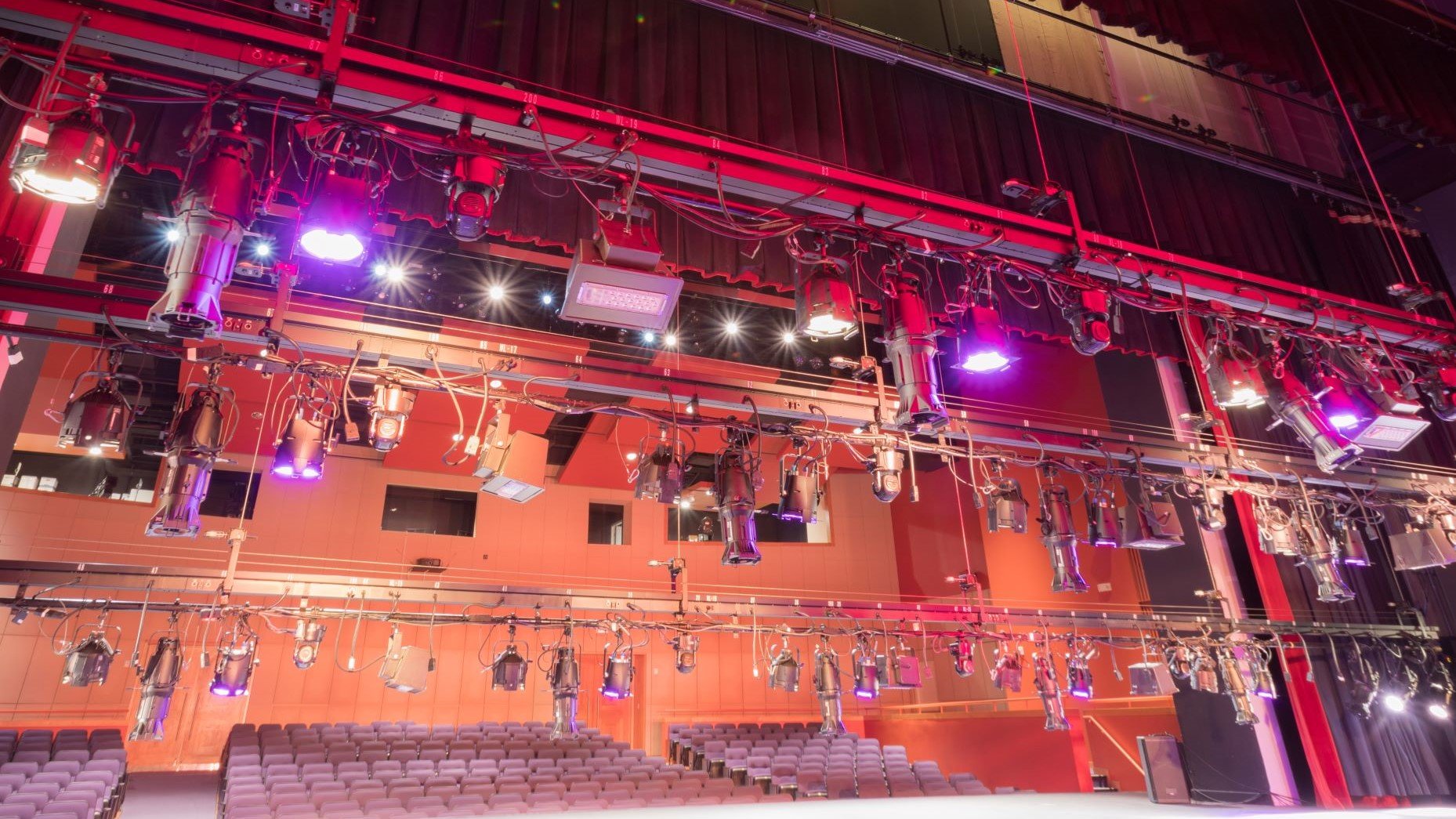In the world of stage lighting, designers rely on a multitude of technical terms to create stunning visual effects. However, understanding these terms can sometimes feel like navigating a maze, with their multiple meanings and interpretations. While delving into every single one would be quite the endeavor, let's shed some light on a handful of our favorites. So, let's dim the house lights and spotlight some terms that may not always be crystal clear.
Glossary of stage lighting terms
Ampere: Amps define the rate of electrical current on a circuit. Electrical circuits are defined by their amperage, which in combination with the supply voltage determines how much wattage can be safely connected to that circuit.
Apron: A part of the stage that extends in front of the proscenium arch.
Array: The term used to describe a collection of LED emitters in a luminaire. The recipe of LED colors in an array defines the type of light that luminaire can produce (the color gamut).
Back light: Light shone on a subject from behind, used to push the subject out of the background and define form.
Backing: A light that illuminates the area behind a door or window.
Backstage: Stage area behind the proscenium and scenery.
Bar: A plain bar or internally wired lighting bar (IWB) suspended above the stage or auditorium onto which spotlights are attached.
Barn doors: Hinged metal flaps that can be attached to the front of Fresnels to adjust the beam shape. These can also be used with other types of lights to reduce glare.
Beam spread: Light from theatrical luminaires typically forms a conical beam – narrow at the fixture and wider as the light gets farther from the fixture. The angle of the cone is called beam spread. This value is important in calculating how much light will hit the stage from a luminaire rigged at a certain distance from the stage.
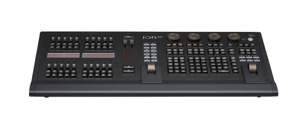 Blind: Changes made to the programmed lighting states that do not affect the current lighting state on stage.
Blind: Changes made to the programmed lighting states that do not affect the current lighting state on stage.
Board: Another term for a lighting control desk or console.
Boom: A vertical lighting bar.
Boom arm: A metal support that attaches a spotlight to a boom.
Build: Slow increase in light intensity.
Check (back): Reduce light intensity.
Circuit breaker: A device that automatically interrupts an electrical circuit when an overloading fault is detected. This is usually caused by a short circuit or too much connected load.
Color call: List of colored filters required for tungsten lighting when rigging a show.
Color filter booklet (or swatch): A small booklet of sample pieces of color filter materials including their name, number and spectral distribution characteristics. These booklets serve as a reference for the lighting designer when choosing the colors for a production. Color filters are generally designed to work on conventional tungsten luminaires, but there are some manufacturers making color filters for white-light LED luminaires as well. Color filter booklets are available from a theatrical equipment dealer.
Control channel: The control channel is the numerical name the designer uses for a luminaire or set of luminaires that are controlled together. Control channels are used to group sets of luminaires or devices together in a logical way relating to how the designer thinks about the design, rather than to their physical location in the venue.
Cross-fade: Gradual change from one lighting state to another where the incoming state replaces the previous state.
Cue: The starting point for a lighting change. A word or action or signal from performer or stage manager that initiates a lighting change or some other change onstage.
Cyclorama (cyc): A white backcloth or painted surface at the rear of the stage.
Dimmer: A device that increases or reduces the power reaching the luminaires in a tungsten lighting system, usually in response to signals from a control desk.
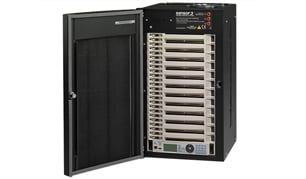 Dimmer rack: A wall mounted or floor standing cabinet which contains a number of dimmers, controlled by a lighting desk. Dimmers in a rack can sometimes be replaced by relays, which turn the power for a circuit on or off, like a switch. The ETC ColorSource ThruPower rack combines dimmers and relays on each lighting circuit – the user can change the setting of each circuit at the rack. The circuit can then be used either with traditional tungsten load (with a dimmer) or with LEDs, moving lights or other devices that require constant power (with a relay).
Dimmer rack: A wall mounted or floor standing cabinet which contains a number of dimmers, controlled by a lighting desk. Dimmers in a rack can sometimes be replaced by relays, which turn the power for a circuit on or off, like a switch. The ETC ColorSource ThruPower rack combines dimmers and relays on each lighting circuit – the user can change the setting of each circuit at the rack. The circuit can then be used either with traditional tungsten load (with a dimmer) or with LEDs, moving lights or other devices that require constant power (with a relay).
DMX512-A: A Digital Multiplex protocol used for controlling dimmers and devices from a lighting control desk.
DMX terminator: A device used to dampen the end of a run of DMX512-A signal. This consists of an XLR-M connector with a 120 ohm resistor soldered between pins 2 and 3. These can be hand-made or purchased from an equipment dealer.
Deputy Stage Manager (DSM): The DSM is the person in charge of running the show on a daily basis. It is their job to call all the lighting cues, scene changes etc, ensuring the performance runs as rehearsed and agreed. All the information, cues, scripts and important notes are kept in a book which never leaves the stage or theatre. The DSM usually sits at the SM desk, sometimes called the prompt desk, on stage left (Prompt side).
Dips: Low level electrical sockets or sockets below the surface of the stage.
Fixed lens: A lens fitted to a profile luminaire that will produce a beam of light at a known or “fixed” angle.
Floodlight: Stage luminaires that produce a wide beam of light. Floods are not normally fitted with lenses.
Focus: To adjust a beam of light to deliver the required beam shape or sharpness.
Follow-spot: A long-throw profile spotlight mounted on a swivel base, used to follow a person as they move around the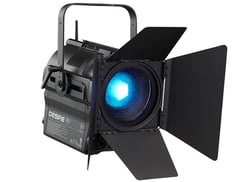 stage.
stage.
Fresnel: A stage luminaire fitted with a Fresnel lens that produces a soft edged, controllable beam of light.
Front of House (FoH): The area in front of the stage or proscenium containing the audience.
Front light: Light that hits a subject from the same direction as the audience is looking. Front light is used for visibility of actors’ faces.
Fuse: A safety device fitted to older dimmer circuits and some plug tops (13A) to detect overload. Modern dimmers use circuit breakers.
Gamut: The color gamut is the complete range of colors that an LED luminaire can produce. The fewer the colors in the LED array, the smaller the color gamut.
Gate: Part of a profile spotlight, located at the internal focal point where gobos and other beam shaping devices can be placed.
Gels: Sheets of colored, transparent material which are fitted at the front of stage luminaires in order to color the beam of light (from Gelatin, the original color filter material).
Gobo: A patterned metal or glass disc which, when fitted into the gate of a profile spotlight, will project the pattern onto the stage, cyc or scenery.
Ground-row: A row of floodlights, used to illuminate a cyc or backcloth from below.
Hook clamp: A hook-shaped clamp used to attach luminaires on to a bar.
Inrush current: A surge of current on an electrical circuit, produced when a device is first turned on. The inrush current of a set of devices may exceed the current rating of a circuit and cause a circuit breaker to trip, even if the normal operating current is under the limit of that circuit.
Iris diaphragm: A device with an adjustable hole, which can be inserted into the gate of a profile to change the diameter of the projected beam.
Kilowatt (kW): 1000 watts.
Lamp: A glass envelope containing a tungsten filament or other lighting source. Not required in LED luminaires.
Lantern: The original term for a stage luminaire.
LED – Light Emitting Diode: An LED is a small electronic device that emits light of a specific color. LEDs may produce very narrow frequencies of light or may produce a wider range of frequencies when manufactured with phosphors. LEDs are combined into arrays to produce the light in entertainment luminaires – the more colors available in an array, the greater the range of colored light a luminaire can produce.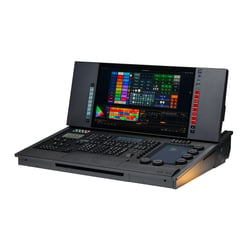
Lighting control desk: The computer used to control connected dimmers and devices and to store programmed cue information for a production. Also known as a light board or console.
Lighting Plan or Light Plot: a schematic drawing of the lighting rig, used to communicate to technicians where to hang luminaires and how luminaires will be patched in the lighting control desk.
Limes: The old name for follow-spots derived from the use of lime – the original light source.
Ohm: A unit of electrical resistance. Conductors (wires) are rated in ohms.
O.P. (Opposite Prompt): A stage direction meaning stage right.
Offstage: Any area of a stage which cannot be seen by the audience.
Onstage: Any area of a stage which can be seen by the audience.
Open white: The term used to describe a light that has no gel fitted. When thinking of LED, this would refer to all emitters being at full, creating white light.
P.S. (Prompt Side): A stage direction meaning stage left.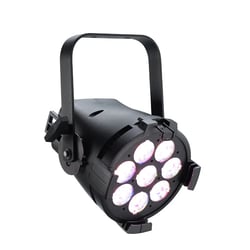
Pan: To move a spotlight or moving light in a generally left-right or horizontal motion.
PARcan: A luminaire based on a sealed beam lamp contained in a simple can-shaped housing.
PAR lamp: Sealed beam lamp to fit into a PARcan.
Patch panel: A physical connection point between numbered circuits in the theatre and the dimmers in the dimmer rack. Patch panels have been replaced by dimmer-per-circuit systems where each circuit is directly wired to a dimmer position in a dimmer rack.
Patching: The linking of dimmer circuits or DMX addresses to control channels in the lighting control desk.
Perch: A stage lighting position located on either side of the proscenium.
Plan: The drawing indicating where all luminaires should be placed and how they should be connected to the lighting system. This drawing is usually drawn to scale.
Plot: The list of cues and other instructions necessary to produce the necessary lighting changes for the entire performance.
Practical: A prop or other electrical device (table lamp, TV, etc) which is operated, or apparently operated, by a member of the cast. Depending upon function, the practical may not be connected to the dimming system.
Preset (1): A term originally applied to a simple manual lighting desk where two groups of faders (A and B) were raised to the levels needed in two different scenes. A cross-fader provided a means to fade between “Preset A” and “Preset B.” Not widely used now.
Preset (2): A term used in some modern control desks to denote a single fader to which a number of channels at different intensities has been assigned and recorded. These may also be known as submasters.
Preset (3): A lighting state on stage before the performance begins.
Profile spot: A stage luminaire fitted with either one (fixed angle) or two lenses (zoom). The profile can project images or patterns (gobos) and can be accurately focused and shaped using internal shutters.
Prompt: Lines fed to an actor who has forgotten his/her place. The “prompter” is the person who would normally give these lines, but this is no longer used in the professional theatre. If lines are missed, the Deputy Stage Manager (DSM) on the “book” will call the missing dialogue. Also see P.S. (above).
Proscenium (arch): An arch or opening in the front wall of the stage, which frames the audience’s view of the show. Some performance spaces have no proscenium; others install a temporary “false proscenium” made from drapes or curtain or scenery flattage.
RCD (Residual Current Device): A safety device connected to an electrical supply to detect whether the current between the energized and return conductors of a circuit is balanced. A difference in current on these two lines can indicate a short circuit or leakage to the earth conductor (a live shock in progress). Imbalance causes the RCD to trip, breaking the circuit.
Record: The process of saving information to a computerized, or memory desk. All the information relating to the show is recorded and will include cues, times, soft patching and other set up procedures. The combined show data is stored in a show file, which can be stored on the console hard disk itself, and to an external memory stick for backup.
Rig: The lighting installation and placement of luminaires for a particular show. The rig may be changed from show to show.
Safety bond: A safety device made of rated clips and wire rope, intended to prevent a stage luminaire falling if the main suspension point fails. Safety bonds have replaced safety chains. Unlike chains, safety bonds can be tested and made to a common safe weight standard. Safety bonds should be weight stamped so the correct bond can be used with the selected luminaire.
Safety chain: A strong welded link chain used to prevent a stage luminaire falling if the main suspension point fails. Replaced by safety bonds.
Shutter: Metal plates that are fitted into the gate position of a profile spotlight, used to control the shape and size of the projected beam.
Sidelight: Light that hits its subject from the left or right (from the point of view of the audience). Sidelight is used to reveal the form of three-dimensional objects or performers.
Special: A light that is intended to perform very specific task, like spotlighting an actor during a big downstage monologue or lighting a presenter at a podium. Specials may be added to help an existing rig better suit the needs of a show.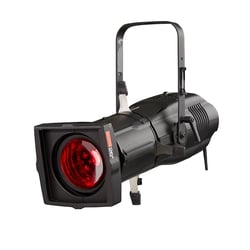
Spigot: A short metal rod which connects a luminaire to a lighting stand.
Spill: Unwanted light from a luminaire.
Spotlight: The generic name for any luminaire which has a controllable beam.
Stage Manager’s desk (SM desk): Located on stage left (PS or prompt side) this is where the DSM on the “book” will call all the cues for the show. In some theatres, the SM desk is located on stage right (O.P. or opposite prompt) this is known as a bastard prompt.
Stirrup: The U-shaped metal supporting hoop attached to a luminaire (also known as a trunnion arm).
Tabs: A set of curtains that can be closed across the front of the stage (behind the proscenium, if there is one).
Throw: The distance from a luminaire to the stage or area on the stage. Throw affects the size of the beam of light and will help to determine which size lens to use.
Thrust stage: a stage that extends into the auditorium and is surrounded on three sides by audience seating.
Tungsten-halogen: The correct description of a tungsten lamp. A thin tungsten filament is supported in quartz-glass envelope filled with a halogen gas.
UV: Ultraviolet light, used for special effects.
Upstage: The area of a stage closest to the back wall or cyclorama.
Volt: A unit of power that quantifies the difference of potential that carries one ampere of current against one ohm of resistance. Electrical supplies are rated in voltage.
Watt: A unit of power that quantifies the rate of energy transfer. Used to describe the power consumption of lamps and devices. Wattage equals a circuit’s voltage multiplied by its amperage (W=VA).
Wings: The side areas of a stage not seen by the audience.
Working lights (1): An independent lighting system, not connected to the stage dimming systems, which can be switched on and off as required by the stage crew.
Working light (2): Lighting is sometimes required on stage for the crew to set a new scene. In some circumstances, normal working lights would be too bright, so a cue is incorporated into the lighting plot allowing the crew to work quickly and safely.
Zoom: A system comprising two lenses that can be adjusted to vary the size and focus of a beam of light from a profile luminaire.
For a more in-depth exploration of the world of stage lighting design, be sure to check out our free digital guide, Stage Lighting Design: An Introduction. This comprehensive resource provides valuable insights and tips to help you master the art of creating impressive lighting effects. Plus, alongside the guide, you can download a set of accompanying posters to enhance your learning experience.
If you're looking for high-quality lighting products to bring your designs to life, look no further than ETC. With a diverse range of innovative lighting solutions, ETC is a trusted name in the industry for delivering exceptional performance and reliability. Visit etcconnect.com to explore the full range of products and take your lighting design to the next level.
If you found this information helpful, don't miss our blog series dedicated to the art of stage lighting design, right here:
Stage Lighting Design, Part 1: Introduction to Lighting
Stage Lighting Design, Part 2: Objectives of Lighting Design
Stage Lighting Design, Part 3: Controllable Properties of Light
Stage Lighting Design, Part 4: Types of Lights
Stage Lighting Design, Part 5: Lighting Angles
Stage Lighting Design, Part 6: Color
Stage Lighting Design, Part 7: Lighting Systems
Stage Lighting Design, Part 8: Planning Your Design
Stage Lighting Design, Part 9: Getting Technical
This blog series is an adaptation of our free digital guide, Stage Lighting Design: An Introduction, based on content written by ETC Outreach and Training Specialist, Declan Randall.


